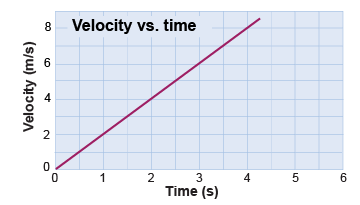 A race car crosses the starting line traveling at 40 m/s. It then instantly starts to accelerate at 9 m/s2. How far does it travel in 5 s? A race car crosses the starting line traveling at 40 m/s. It then instantly starts to accelerate at 9 m/s2. How far does it travel in 5 s?

 A student uses a robot cart as real-time technology to generate the velocity versus time graph above, which shows the cart increasing its speed steadily for 4 s. The area under the graph equals the distance the cart traveled. A student uses a robot cart as real-time technology to generate the velocity versus time graph above, which shows the cart increasing its speed steadily for 4 s. The area under the graph equals the distance the cart traveled.
- Generate a table of the total distance traveled for each of these four time intervals: 0 to 1 s, 0 to 2 s, 0 to 3 s, and 0 to 4 s. What pattern do you find?
- Generate a bar chart that shows the total distance traveled during each subsequent second (0 to 1 s, 1 to 2 s, 2 to 3 s, and 3 to 4 s). What pattern do you find in these distances?
- Make an inference from the bar chart you generated in (b): If this motion continues until time t = 6 s, then how far will the robot travel during the sixth second (from 5.0 to 6.0 s)?
- Generate a one-dimensional “ticker tape” chart (such as on page 6) showing the cart's position from 0 to 4 s every 0.5 s. Plot a dot for the robot’s position at each time, starting at the origin.
- Interpret the “ticker tape” chart you generated in (d). How does the pattern of dots show you that the velocity of the robot is changing?
- A ball is thrown straight up at 15 m/s.
- How long does it take to reach its highest point?
- How long does it take to hit the ground?
- Write an expression for height x as a function of time t.
- Graph height x versus t. Label the point of highest height and the time it reaches the ground.
- From what height should you drop a ball so that it hits the ground at 40 m/s? How long will it take to hit the ground?
- What is the average acceleration of a rocket that travels 400 m in 5 s if it starts from rest?
| | - How long a runway does a plane need to accelerate from rest to a take-off speed of 50 m/s at a comfortable acceleration of 0.3g or 3.27 m/s2? How long does it take for the plane to reach take-off speed?
- A basketball player can jump 0.65 m off the ground. How fast must the player be going when she leaves the ground?
 Bill throws a ball up in the air at 17 m/s. How long will it take for it to fall back to him? Bill throws a ball up in the air at 17 m/s. How long will it take for it to fall back to him?
 Eve is standing at the top of a cliff. If she drops a rock off of the cliff and it takes 2.5 s to hit the ground, how tall is the cliff? Eve is standing at the top of a cliff. If she drops a rock off of the cliff and it takes 2.5 s to hit the ground, how tall is the cliff?
 Four seconds after being launched, what is the height of a ball that starts from a height of 12 m with an initial upward velocity of 24 m/s? Four seconds after being launched, what is the height of a ball that starts from a height of 12 m with an initial upward velocity of 24 m/s?
 A person drops a penny from a window that is 50 m high. Neglecting air friction, calculate the speed of the penny when it hits the ground. Do you think the penny would actually fall this fast or would air friction slow it down? A person drops a penny from a window that is 50 m high. Neglecting air friction, calculate the speed of the penny when it hits the ground. Do you think the penny would actually fall this fast or would air friction slow it down?
 A juggler throws a ball upward at 9 m/s. One second later the juggler throws a second ball upward at the same speed. At what height do the balls reach the same position but are moving in opposite directions? (Hint: to solve this problem you must use the fact that (t − 1)2 = t2 − 2t + 1.) A juggler throws a ball upward at 9 m/s. One second later the juggler throws a second ball upward at the same speed. At what height do the balls reach the same position but are moving in opposite directions? (Hint: to solve this problem you must use the fact that (t − 1)2 = t2 − 2t + 1.)
 An arrow is launched straight up. What is the initial velocity the arrow must have to reach a height of 500 m? (Hint: At the highest point the arrow reaches, its velocity is v = 0.) An arrow is launched straight up. What is the initial velocity the arrow must have to reach a height of 500 m? (Hint: At the highest point the arrow reaches, its velocity is v = 0.)
 A train conductor sees an obstruction on the track 300 m ahead of the train. If the train is traveling at 24 m/s and it takes the conductor 0.5 s to apply the brakes, what must the train’s acceleration be to stop before hitting the obstruction? Is this acceleration a reasonable value for a real train? A train conductor sees an obstruction on the track 300 m ahead of the train. If the train is traveling at 24 m/s and it takes the conductor 0.5 s to apply the brakes, what must the train’s acceleration be to stop before hitting the obstruction? Is this acceleration a reasonable value for a real train?
 How far does a marble fall during its ninth second of free fall from rest? How far does a marble fall during its ninth second of free fall from rest?

 A person in a floor above you drops his mobile phone out the window. It takes 0.2 s for the phone to fall 2 m past your window. Estimate how far above you the person must have dropped the phone. A person in a floor above you drops his mobile phone out the window. It takes 0.2 s for the phone to fall 2 m past your window. Estimate how far above you the person must have dropped the phone.
|

